Lutein
Carotenoids are organic plant pigments which largely occur in chloroplasts of green plants and algae. They are highly abundant in fruits, vegetables and green plants, with more than 600 found in nature. Birds (yellow and red feathers and egg yolk), fish and crustaceans (orange-red skin and flesh), and invertebrate animals have pigments in free forms or as complexes with proteins which responsible for the wide variety of colors in animals. Animal Carotenoids originate from plants where it gets absorbed from the diet. Carotenoids can be classified into two group which are the provitamin A Carotenoids (those that can be converted to vitamin A in the human body) and the non-provitamin A Carotenoids (those that cannot be converted to vitamin A in the human body).
There are only about 30 to 50 Carotenoids commonly associated with human diet and approximately 20 are found in human blood and tissues. Lutein and its stereo isomer, zeaxanthin belong to the xanthophylls (non-provitamin A) family of Carotenoids which are mostly concentrated in the ocular tissues such as the lens and macula lutea. As hypothesized, carotenoid plays a similar role in humans as in the plants where it generates the potent antioxidants and effective screeners of high energy blue light. Lutein is a yellow carotenoid and present as the second most abundant Carotenoids in human serum along with other Carotenoids (Table 1).
Lutein is famously known for its value for eye health such as age-related macular degeneration (AMD) and cataracts. However, the beneficial characteristics of Lutein do not only help in preventing eye disease but also with other body health. In many recent studies, it was suggested that Lutein and zeaxanthin may also contribute to maintain heart and skin health. As the importance of Lutein in human health becoming obvious in the society, more investigations have been performed over the years to demonstrate its performance in human health.
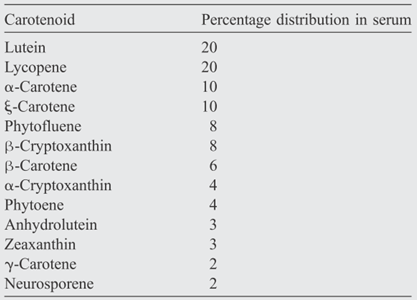
Chemistry of Lutein
Lutein and zeaxanthin belongs to xanthophylls which make them significantly different from other Carotenoids as they contain oxygenated substituents. It contains two hydroxyl groups at each end of the molecule that plays an important role in their biological function and provides unique biochemical properties (Figure 1). Lutein [(3R,3’R,6’R)-β-carotene-3,3’-diol] and zeaxanthin [a mixture of (3R,3R’)-β,β-carotene-3,3’-diol and (3R,3’S-meso)-β,β-carotene-3,3’diol] are structurally related to β-carotene. Lutein and zeaxanthin are isomers of each other, differs in the position of one of the double bonds. In contrast, hydrocarbon Carotenoids such as β-carotene and lycophene have no oxygen atom. Therefore, the hydroxyl groups on Lutein and zeaxanthin allow them to orient within cell membranes and lipoproteins in way other Carotenoids cannot. The polarity of Lutein and zeaxanthin increases due to the presence of hydroxyl group. The double bonds contribute to the Carotenoids’ color and to their ability to quench free radicals. The peak absorption of Lutein that occur at 466nm in the visual light spectrum will screens out blue light and protects plants (Figure 2). Besides that, it also allows other wavelengths of light to go through for photosynthesis.
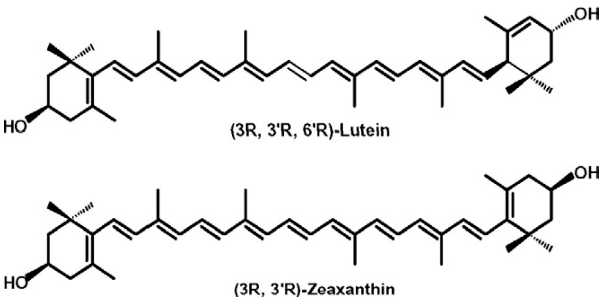

Sources and Dietary Intake of Lutein
Like other Carotenoids, Lutein and zeaxanthin, are not produced by the human body and must be consumed in the diet. Lutein and zeaxanthin are highly present in dark green leafy vegetables such as spinach and kale. In 100g of spinach, as much as 12mg of Lutein can be found and up to 40mg can be found in 100g of kale. Besides dark green leafy vegetables, foods with yellow color such as corn and egg yolks also serve a good dietary source of lutein. Table 2 shows the various foods that with the different levels of Carotenoids.
Vegetable Carotenoids are in all-trans form as the presence of a carotenoid isomerase in plants catalyses the isomerization of poly-cis-carotenoids to all-trans-carotenoids. Therefore, all-trans-lutein is isomerised in plants. The presence of geometrical Lutein cis-isomers (9-cis, 9’-cis, 13-cis and 13’-cis) are reported present in fresh vegetables. The presence of cis isomer lutein in fruits and vegetables is attributed to chlorophyll derivatives that act as sensitizers. These sensitizers induce isomerization of all-trans-carotenoids into their respective cis forms. However, it has been found that despite the fact that fresh kales have chlorophyll, they do not have cis-isomers or have them in very low quantities.
Besides that, oral supplementation with lutein is also largely available in the market to increase the dietary intake of lutein. The variety of supplement products contains around 6 to 25mg per capsule of lutein. The average daily intake of Lutein is currently around 1.7mg per day in the United States whereas data from Europe shows that Europeans consume approximately 2.2mg per day. The levels of lutein consumption are below the levels purported to reduce the risk of eye diseases, such as cataracts and age-macular-degeneration (AMD).
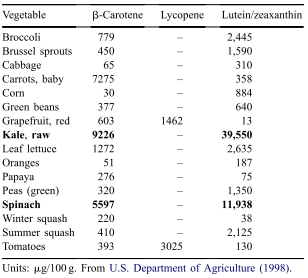
Bioavailability of Lutein
The bioavailability of lutein is important as carotenoids are not synthesized by humans and the concentration of those compounds in humans depends on their intake and their bioavailability. The amount of lutein that is found in plasma depends on the amount of carotenoids ingested into individual’s digestive system. The requisite for absorption of food components is that it has to be released from the matrix. This guarantees its accessibility to the brush border in the small intestine for its active or passive absorption by enterocytes. Studies have been performed by using the analysis of the concentration of Lutein in serum after the intake of matrix containing this compound. Besides that, intragastrical feeding is another way to detect the concentration of lutein in the body.
Lipid soluble molecules, vitamin E, and carotenoids are absorbed in the duodenum. It was suggested that the intestine has no active carriers or transporters for carotenoids. According to studies, absorption of carotenoids and fatty acids transportation is facilitated from the lumen to the other side of membrane by the enterocytes. On the serosal side, they are incorporated into chylomicrons. They reach the circulatory system through the inferior vena cava. From the vena cava, the chylomicrons are transferred to the liver in which they get incorporated into lipoproteins by the hepatocytes. The carotenoids are transported in the circulation in form high density lipoproteins (HDLs) or low-density lipoproteins (LDLs) which are the main transport forms of carotenoids. In most cases, hydrocarbon carotenoids are evident in LDL fractions. Subsequent release into the systemic circulation will start to happen.
There are several factors that can influence the bioavailability of lutein. The absorption process of lutein heavily depends on time and variables such as whether the food is cooked, raw or processed; efficiency of digestion; and the food components. Besides that, one important factor is solubility. Free or esterified lutein is practically insoluble in aqueous systems, and their solubility in food grade solvent is very limited. Other factors including the source of lutein, their interaction with other carotenoids, etc. also can influence their absorption. It was found out that the bioavailability of beta-carotene and lutein varies substantially depending on the variety of the vegetables. In addition, the form lutein is in can also affect their bioavailability. Bioavailability of lutein from vegetable sources increases due to treatments like chopping and cooking as compared to whole raw foods. Compared to lutein, lutein esters are less prevalent in the diet. Lutein esters have fatty acids attached to both ends of the molecule.
These fatty acids have to be removed by gut lipases and esterases before lutein esters are absorbed. De-esterification of lutein esters is impacted by dietary fat content hence its bioavailability is less than lutein that is not esterified. In a study done by Bowen et al, it was speculated that lutein diester formulation is more bioavailable than free lutein formulation in the subjects they were doing the study with. Association and digestibility of food matrices also influence carotenoid absorption. Lutein absorption from a carotenoid supplement is double the amount of lutein derived from vegetable sources like the spinach. Diet supplementation of lutein added to foods help to create antioxidant formulas due to the low bioavailability of lutein. It was indicated that their consumption could aid in the prevention of some diseases. Most of the lutein used in commercial products is extracted from marigold flowers.
Biosynthetic Pathway of Lutein
During the biosynthesis of lutein, phytoene is converted to phytofluene through the action of the enzyme phytoene desaturase which again acts on phytofluene to form beta-carotene. Phytoene desaturase enzyme subsequently acts on β-carotene to form neurosporene. The activities of phytoene desaturase lead to formation of lycophene. Lycophene cyclase acts on lycophene leading to formation of δ-carotene. The action of lycophene β-cyclase on δ-carotene leads to formation of α-carotene. α-carotene is finally acted upon by β-carotene hydroxyls to form lutein and its isomer zeaxanthin. This is illustrates in Figure 3 below.

Lutein Metabolism
It was stated that carotenoid absorption is improved by the mechanical breakdown in the tissue that releases the carotenoids. Carotenoids are absorbed into gastrointestinal mucosal cells and do not normally appear changed in the human circulatory system and in the human tissues. Then, the carotenoids are absorbed in the intestine by passive diffusion after their incorporation into micelles formed by dietary fats and bile acids. Carotenoids found in the micelles are usually incorporated into chylomicrons. They are subsequently released into the lymphatic system. Before they are released into the bloodstream, they are incorporated into lipoprotein at the site of the liver. Their absorption takes place differentially depending on the tissue.
Previous findings in studies found out that the carotenoids absorption is not passive but it is facilitated process requiring class B-type 1 scavenger receptors. Lutein is a fat soluble substance. Therefore, it follows the same intestinal absorption as dietary fat. Lutein extraction begins in the stomach. Efficiency of transfer of the carotenoids depends on the matrix characteristics, carotenoid lipophilic properties, the medium pH and the characteristics of the lipid. Absorption of carotenoids entails
- digestion of food matrix,
- dispersion of the carotenoids in liquid emulsion particles,
- its transportation to the intestinal epithelial cells,
- bile salts micelle formation,
- carotenoid repackaging into chylomicrons in the cells of the epithelia,
- transportation of the carotenoids and
- their metabolites across the plasma membrane.
Lipid matrix has components like cholesterol, triacylglycerides (TG), and phospholipids. This was demonstrated in a study whose results showed that eating of test meal that has high cholesterol content enhances higher postprandial response in a variety of lipoprotein fractions. In the process of food absorption, carotenoids are released by the intact food. These are further transformed into lipid droplets hence forming micelles. In spinach, lutein is located in the chloroplast. Owing to the difficulty of release of lutein from the spinach matrix, their availability from vegetables is relatively lower as compared to other supplements. Studies indicate that there are other components in the spinach that can influence the bioavailability of lutein through their action in the metabolism of lutein. Such components include beta-carotene, folate, and the vitamin C. Beta-carotene is more accessible in in-vitro digestion system when spinach is cooked in presence of oil than when cooked without oil.
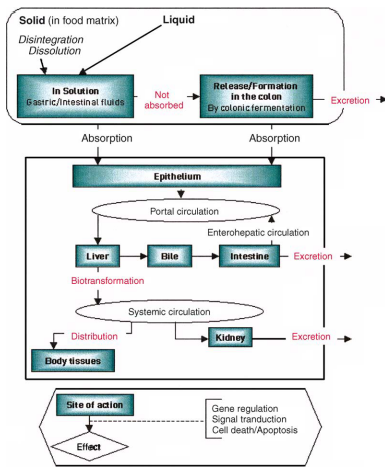
Human Health
Most studies on carotenoids were on the total carotenoid content or those that have activity as provitamin A until the 1990. In the recent years, the further understanding in individual components of main carotenoids present mainly in fruits and vegetables shows its importance to human health. Studies are done by testing the presence of carotenoids in human serum as carotenoids are only available to the human body through food. Studies have been focusing on several different aspect of health such as eye health, skin health and cardiovascular health.
Lutein and Eye Health
Lutein has been associated with eye health as it was found to be present largely in the eyes. It is known as an eye protective nutrient. When light enters the eyes, it passes through the cornea, followed by the pupil as shown in Figure 5. The light will pass through aqueous humor and the light is focused by the lens of the eye. Vitreous humor will transmit the focused light and finally strikes the retina. Then, the light energy will be converted to nerve impulses by the retina and it will be transmitted to the brain by the optic nerve where they are interpreted as sight.
Lutein and zeaxanthin are concentrated in the macular region of the retina. Lutein is largely distributed throughout the retina and zeaxanthin dominated the central macula. Besides that, meso-zeaxanthin, another type of xanthophyll has also been identified in human macula and appears to be a photochemical transformation product derived from lutein or zeaxanthin in the retina. Maintenance of the health of the macular is very critical for normal vision sustenance. Carotenoids in plants are capable of absorbing light of similar wavelength to that of macular, show that they both serve protective roles. Lutein is a photo-protective agent that screens out dangerous blue light from the sun. Lutein also protects cells of the macular because of its anti-oxidative properties. Lutein and zeaxanthin inhibit drusen formation. It also acts as scavenger for free radicals; a feature that helps it to preserve macular health. Lutein is a bioactive carotenoid. Xanthophyll binding proteins helps in transporting lutein as well as aiding its metabolism in the retina.
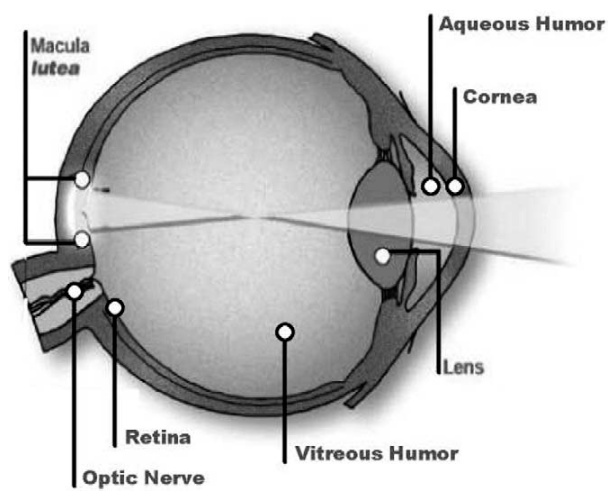
The lens is the first line of defense of oxidative stress occasioned by intense light exposure in human eyes. Lutein acts as a screen to high-energy blue light and as a functional antioxidant. These features make lutein to be thought of as playing a role in reduction of risks related to age-related macular degeneration (AMD), cataracts, and other eye infections. AMD is the major cause of blindness in populations aged 65 years and above because it causes the degeneration of part of the retina and the macular. Early AMD is caused by photo-oxidative damage and depigmentation of the epithelia of the retina. Late AMD will result in scar tissues accumulation. Diets that are high in carotenoids like fruits and vegetables help reduce the risks associated with age related macular disease. Serum carotenoids including lutein have inverse relationships with AMD. Cataract is caused by oxidative damage in the lens cell membranes and increased lipid peroxidation products detected in lens and aqueous humor of patients with cataracts. By absorbing the blue-light, the photoreceptor cell layer in the eyes will be protected by the macular pigment from light damage.
Lutein and Skin Health
Skin is the largest organ in the human body which is exposed to the risk of environmental insult. UV light exposure is thought to be the most harmful to the human skin and will cause oxidative stress, inflammation, erythema, breakdown of extracellular matrix, wrinkling and skin cancer. Lutein is thought to protect the skin from high-energy blue light when they are ingested by the human beings or when applied topically on the skin, considering its ability to act as an antioxidant and absorb blue light in the eyes. Evidence shows that lutein and other carotenoids can protect the skin against damages that are induced by ultra violet rays. Studies conducted show that prolonged exposure to the ultra violet rays reduces carotenoids found in the serum and the skin.
Consumption of lutein helps in maintaining skin health through ultra violet erythematic reduction. When the skin is exposed to UVA and UVB rays, an inflammatory response in skin cells is mediated by reactive oxygen species hence causing the appearance of erythematic or a red swollen appearance on the skin. Carotenoids reduce such inflammatory response in human beings. Study done by Stahl et al (2000) show that subject undertaking a carotenoid supplement for 12 weeks developed less erythema in response to UV irradiation at week 12 relative to week 0 of the testing. Absorption of light in the UV range by carotenoids is normally mediated by their antioxidant functions because they cannot absorb light in such a range. Individuals who take multivitamin supplements normally have high levels of lutein in their serum. Evidence obtained from animal models show that addition of 5 µg of lutein to mice skin inhibits UVB-induced epidermal cell proliferation. Mice fed on a diet supplemented with purified lutein decreases UVB induced skin inflammation. Lutein protects the skin from skin cancer by its ability to filter blue light. Finally, lutein can also act to scavenge the reactive oxygen species and other free radicals.
Lutein and Chronic Diseases
Cardiovascular disease
Coronary heart disease incidence has some inverse relationship with fruits and vegetable consumption. This is attributed to presence of antioxidants like carotenoids that are found in such foods. Adhesion of molecules on the cell surface of endothelial cells is one of the biomarkers in atherosclerosis pathogenesis. It was found out that the expression of adhesion molecules was reduced when the cultured endothelial cells were treated with lutein. This showed the protective effects of lutein. Lutein can also inhibit the LDL-induced movement of the monocytes to the lumen and the cell wall of arteries which is the first lesion of arthrosclerosis. The inhibitory effects are more pronounced when cells are pre-treated with lutein. People with high levels of lutein in their serum are less likely to suffer from coronary heart diseases. Increasing dietary intake of fruits and vegetables like kale and spinach guards an individual against stroke. Additionally, consumption of lutein is inversely related to the incidences of subarachnoid hemorrhage. Moreover, the in-take of β-carotene or lycophene has got an inverse relationship with cases of cerebral infarction.
Cancer
As lutein is highly related to eye health, the protective role of lutein against cancer is not fully established. Cancer has been one of the most common chronic disease that hits the human population in the 21st century. However, growing evidence of the protective effects of lutein suggested that it may help in the prevention against cancers of breast, colon, lung, skin, cervix and ovaries. Studies are majorly done on animal subjects. The antioxidant effect of lutein is related with lower DNA damage and higher repair activity. The intake of carotenoids such as lycopene and lutein was reported to exert a cancer-protective effect via a decrease in oxidative and other damage to DNA in humans. Table 3, shows a summary of lutein on the different types of cancer. In several studies, the greater consumption of fruits and vegetables serves greater protection against cancer. However, some studies found out that rich diets in variety of carotenoids are not associated with prevention of cancer. There are contradicting conclusions on the prevention of cancer associated with the consumption of carotenoids. Therefore, detailed studies must be done in order to prove its effect on cancer.
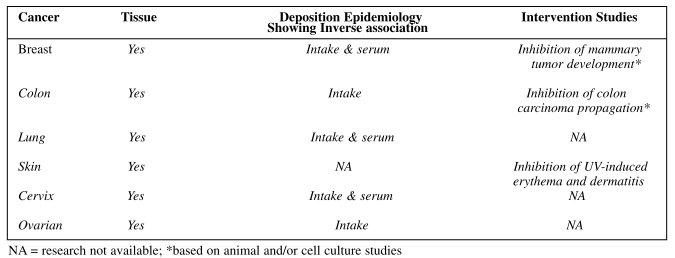
Conclusion
Future direction
Research that try to demystify the protective role of lutein in human beings keeps evolving from epidemiological, animal, and human intervention into in-vitro cell culture studies [34]. More researches should be conducted to illuminate changes in isomerization, epimerization, oxidation, and degradation of lutein that arise when foods that contain lutein are subjected to heat treatment or other industrial processes. Inter-laboratory studies should be done to try to come up with an accurate method of determining concentrations of lutein as well as quantification of its geometrical isomers. Furthermore, improvement of knowledge on lutein should be invested in other carotenoids of interest like beta-carotene. Additionally, research should be conducted to evaluate the exact effects of inclusion of zeaxanthine and lutein in the diet relative to other nutrients found in fruits and vegetables.
Summary
Lutein is present in plasma and other organic fluids. It is known to possess antioxidant properties. The human body is unable to synthesize lutein and thus it has to be supplied from the diet or through supplementation. It is abundant in fruits, vegetables, egg yolk, and milk. In vegetables lutein occur in the form of all-trans-lutein. However, some geometrical isomers; epoxi-lutein; esterified lutein; and protein linked lutein are also present. The influence of these other forms of lutein on human health is yet to be established. Controversy has sparked on whether carotenoids consumption or consumption of fruits and vegetables are important for proper functioning of human beings.
Lutein is strongly implicated in protection against cataracts and age related macular diseases. AMD is a public health concern in developed countries that have large proportions of aging populations. Adults aged 60 years and above, are more likely to suffer from AMD complications. Containing incidences of AMD has been a public health concern. Lutein and zeaxanthine occur in high concentrations in the lens whereby they protect specific regions of the eye against harmful radiations. In addition, lutein is found not only to benefits the eye but also other parts of the human body as well. The antioxidant properties of lutein and its isomers help in prevention of many diseases in the body. Hence, more researches are to be done to determined more benefits of lutein and also to enrich the intake of lutein in different sources for human intakes.
References
Johnson, E.J., A Biological Role of Lutein. Food Reviews International, 2004. 20(1): p. 1 – 16.
Perera, C.O. and G.M. Yen, Functional properties of carotenoids in human health. International Journal of Food Properties, 2007. 10(2): p. 201-230.
Roberts, R.L., J. Green, and B. Lewis, Lutein and zeaxanthin in eye and skin health. Clinics in Dermatology, 2009. 27(2): p. 195-201.
Shao, A., The Role of Lutein in Human Health. The Journal of the American Nutraceutical Association, 2001. 4(2): p. 7-19.
Alves-Rodrigues, A. and A. Shao, The science behind lutein. Toxicology Letters, 2004. 150(1): p. 57-83.
Calvo, M.M., Lutein: A Valuable Ingredient of Fruit and Vegetables. Critical Reviews in Food Science and Nutrition, 2005. 45(7): p. 671 – 696.
Astner, S., et al., Dietary Lutein/Zeaxanthin Partially Reduces Photoaging and Photocarcinogenesis in Chronically UVB-Irradiated Skh-1 Hairless Mice. SKin Pharmacology and Physiology, 2007. 20: p. 283-291.
Krinsky, N.I., J.T. Landrum, and R.A. Bone, Biologic Mechanisms of the Protective Role of Lutein and Zeaxanthin in the Eye. Annual Reviews 2003. 23: p. 171-201.
Johnson, E.J., The Role of Lutein in Disease Prevention. Nutrition in Clinical Care, 2000. 3(5): p. 289-296.
Dwyer, J.H., et al., Oxygenated Carotenoid Lutein and Progression of Early Atherosclerosis : The Los Angeles Atherosclerosis Study. Circulation, 2001. 103(24): p. 2922-2927.
Dorgan, J.F., et al., Relationship of serum carotenoids, retinol, α-tocopherol and selenium with breast cancer risk: results from a prospective study in Columbia, Missouri (United States). Cancer Causes and Control, 2004. 9(1): p. 89-97.
De Sio, F., et al., A chromatographic procedure for the determination of carotenoids and chlorophylls in vegetable products. Acta Alimentaria, 2001. 30(4): p. 395-405.
Carpentier, S., M. Knaus, and M. Suh, Associations between Lutein, Zeaxanthin, and Age-Related Macular Degeneration: An Overview. Critical Reviews in Food Science and Nutrition, 2009. 49(4): p. 313 – 326.
Bryant, J.D., et al., Isolation and partial characterization of.alpha.- and.beta.-carotene-containing carotenoprotein from carrot (Daucus carota L.) root chromoplasts. Journal of Agricultural and Food Chemistry, 1992. 40(4): p. 545-549.
Deli, J., et al., Epimerisation of lutein to 3′-epilutein in processed foods. Bioorganic & Medicinal Chemistry Letters, 2004. 14(4): p. 925-928.
De La Cruz-García, C., et al., The effects of various culinary treatments on the pigment content of green beans (Phaseolus vulgaris, L.). Food Research International, 1997. 30(10): p. 787-791.
Dachtler, M., K. Kohler, and K. Albert, Reversed-phase high-performance liquid chromatographic identification of lutein and zeaxanthin stereoisomers in bovine retina using a C30 bonded phase. Journal of Chromatography B: Biomedical Sciences and Applications, 1998. 720(1-2): p. 211-216.
Bowen, P.E., et al., Esterification Does Not Impair Lutein Bioavailability in Humans. J. Nutr., 2002. 132(12): p. 3668-3673.
van den Berg, H. and T. van Vliet, Effect of simultaneous, single oral doses of beta-carotene with lutein or lycopene on the beta-carotene and retinyl ester responses in the triacylglycerol-rich lipoprotein fraction of men. Am J Clin Nutr, 1998. 68(1): p. 82-89.
Socaciu, C., Food colorants: chemical and functional properties. 2007: CRC Press.
Chen, B.H., H.Y. Peng, and H.E. Chen, Changes of Carotenoids, Color, and Vitamin A Contents during Processing of Carrot Juice. Journal of Agricultural and Food Chemistry, 1995. 43(7): p. 1912-1918.
Chen, B.H., Studies on stability of carotenoids in Garland Chrysanthemum (Ipomoea spp.) as affected by microwave and conventional heating. Journal of Food Protection, 1992. 55(4): p. 296-300.
Ribaya-Mercado, J.D. and J.B. Blumberg, Lutein and Zeaxanthin and Their Potential Roles in Disease Prevention. J Am Coll Nutr, 2004. 23(suppl_6): p. 567S-587.
Breithaupt, D.E., Simultaneous HPLC determination of carotenoids used as food coloring additives: applicability of accelerated solvent extraction. Food Chemistry, 2004. 86(3): p. 449-456.
Bidoli, E., et al., Micronutrients and laryngeal cancer risk in Italy and Switzerland: a case-control study. Cancer Causes and Control, 2003. 14(5): p. 477-484.
Rapp, L.M., S.S. Maple, and J.H. Choi, Lutein and Zeaxanthin Concentrations in Rod Outer Segment Membranes from Perifoveal and Peripheral Human Retina. Invest. Ophthalmol. Vis. Sci., 2000. 41(5): p. 1200-1209.
Evans, J., Something New Under the Sun: Lutein’s Role in Skin Health. American Journal of Lifestyle Medicine, 2009. 3(2): p. 349-352.
Borel, P., Factors Affecting Intestinal Absorption of Highly Lipophilic Food Microconstituents (Fat-Soluble Vitamins, Carotenoids and Phytosterols). Clinical Chemistry and Laboratory Medicine, 2005. 41(8): p. 979-994.
Stahl, W., et al., Carotenoids and carotenoids plus vitamin E protect against ultraviolet light-induced erythema in humans. Am J Clin Nutr, 2000. 71(3): p. 795-798.
Cardinault, N., et al., Short-term supplementation with lutein affects biomarkers of lutein status similarly in young and elderly subjects. Experimental Gerontology, 2003. 38(5): p. 573-582.
Cano, M.P. and M.A. Marin, Pigment composition and color of frozen and canned kiwi fruit slices. Journal of Agricultural and Food Chemistry, 1992. 40(11): p. 2141-2146.
Buratti, S., et al., Rapid Electrochemical Method for the Evaluation of the Antioxidant Power of Some Lipophilic Food Extracts. Journal of Agricultural and Food Chemistry, 2001. 49(11): p. 5136-5141.
Marse-Perlman, J.A., et al., Lutein and Zeaxanthin in the Diet and Serum and Their Relation to Age-related Maculopathy in the Third National Health and Nutrition Examination Survey. Am. J. Epidemiol., 2001. 153(5): p. 424-432.
Sommerburg, O., et al., Fruits and vegetables that are sources for lutein and zeaxanthin: the macular pigment in human eyes. British Journal of Ophthalmology, 1998. 82(8): p. 907-910.
Bone, R.A., et al., Lutein and Zeaxanthin Dietary Supplements Raise Macular Pigment Density and Serum Concentrations of these Carotenoids in Humans. J. Nutr., 2003. 133(4): p. 992-998.